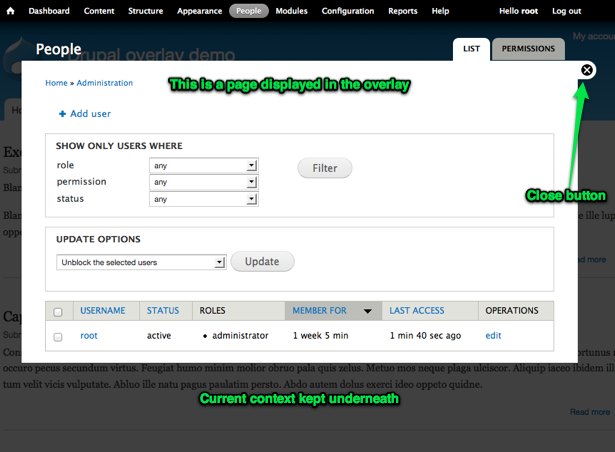
The articles on this page are ComputerMinds' contribution to the Planet Drupal aggregated article feed. Planet Drupal is intended to collate interesting and useful Drupal content from around the web.
[Drupal Science Camp][dsc] was the first Drupalcamp in the UK of 2012. It was wonderfully organised by [Rachel Lawson][rl] and [Euan Bayliss][eb] at a magnificent venue provided free of charge by Napp Pharmaceuticals Limited. Computerminds had the privilege of being one of the sponsors of the event. It was great to be able to support a weekend of learning and general Drupal fun. We'd like to say a big thank you everyone involved with the...
Drupal 7 ships with a module called 'Overlay', it is installed by the standard install profile and actually is pretty great for most people. If you don't know what I'm talking about then, it's this:  It's basically a nice wrapper around the [jQueryUI Dialog component][jquery_ui_dialog] and has some nice features, like keeping the URL fragment up to date with the page being viewed in the overlay. This means you can create a link that...
It's basically a nice wrapper around the [jQueryUI Dialog component][jquery_ui_dialog] and has some nice features, like keeping the URL fragment up to date with the page being viewed in the overlay. This means you can create a link that...
If you are free on the weekend of the 21st and 22nd and are anywhere near Cambridge (the UK one!) then make your way to the Drupal Science Camp. The details on their website are a little sparse so far, but it's shaping up to be an interesting little event - plus ComputerMinds are sponsoring it, so it's got to be good :) Tickets are a measly £10 each, and it looks like there is...
[varnish]: https://www.varnish-cache.org/ [monit]: http://mmonit.com/monit/ We put almost all of our Drupal sites behind the excellent [Varnish HTTP accelerator][varnish], and it gives us a massive performance boost for most site visitors. However it seems to have a tendency to crash without warning and occasionally just dies, leaving our sites down. We workaround this issue by using another piece of useful kit, called [Monit][monit], that keeps an eye on processes on your server and restarts them if...
We recently needed to migrate all our sites on one physical server to another server, there were more than 200 sites, and they were all hosted with Aegir. The old server was to be decommissioned, so we had to move all of Aegir's data about the site to the new server import into a new Aegir master on the new server. We also needed to do this with as small amount of downtime as possible...
As the year draws to a close we thought it would be appropriate to look back at an exciting year in for Drupal modules, and to list our top 5 Drupal modules of 2011. To qualify for the list the module had to have it's first release in 2011, and have a Drupal 7 version - other than that, anything goes. Workbench The workbench module attempts to provide the sort of editorial interface that many...
Drupal 7 brought us Entities, and with them the powerful [Field API][] for 'storing, loading, editing, and rendering field data.' attached to them. If you're managing everything through 'manage fields' and 'manage display' tabs of your content type, then every part of that process is rather wonderfully taken care of for you. [Field API]: http://api.drupal.org/api/drupal/modules--field--field.module/group/field/7 We often, however, come across the need to render a field outside the context of it's entity. A common example might include rendering a node's author in a sidebar block. Sure, modules like Panels and CCK Blocks will do this for you, but doing it manually is actually not that hard.
Most projects start with you trying out something locally, getting it working and then after some initial testing you might then want to publish the project on Drupal.org. Sandboxes are a great way to throw up some code and the perfect place to pop random code that others might find useful or a project that you just don't want to maintain. If you go and create one on Drupal.org then you'll get helpful instructions for...
In Drupal 6, if you called node_load then what you'd be returned would be your own copy of the node to change and modify as you pleased, but in Drupal 7 this was changed. By default, what you actually get back from a node_load is essentially a reference to a global singleton for that node. This has the interesting side effect of meaning that if you change anything in the node object, you are probably...
Here's a quick follow-up to my original post on Dynamic forms in Drupal 7, as a reply to Wappie08, who asked me about combining conditions in the #states array to add increased control over the display of your form elements. The question: Hi James Williams, I read your blog post about d7 & #states in the FAPI which is really cool! One problem is that the information is also listed in the drupal.org example module...